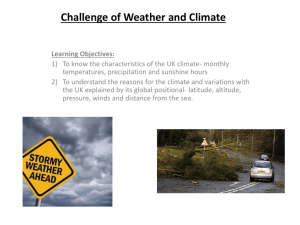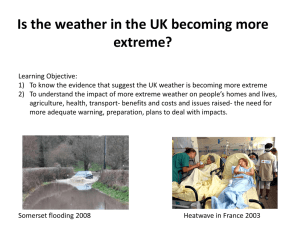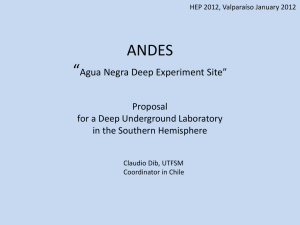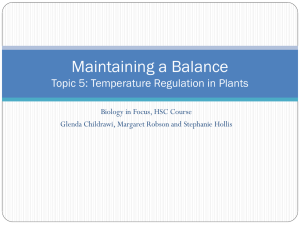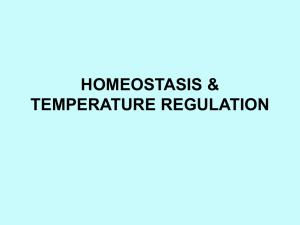Diapositiva 1
advertisement
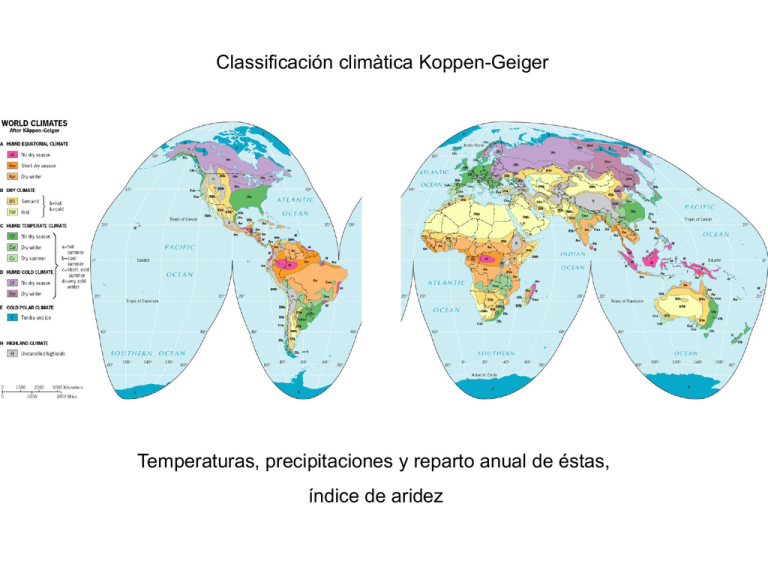
Classificación climàtica Koppen-Geiger Temperaturas, precipitaciones y reparto anual de éstas, índice de aridez http://severe.worldweather.wmo.int/ Venezuela: Past weather and climate • • Venezuela is the northernmost South American country with a long Caribbean Sea coastline. The main chain of the Andes runs from west to east, leaving a narrow coastal plain. To the west there is an extensive marshy plain around Lake Maracaibo whilst to the south lies the large lowland area around the Orinoco valley (the Llanos). This latter area has a typical tropical climate with a single rainy season. Venezuela is unusual among South American countries in that almost everywhere the main rainy season is from April to October at the time of high sun. Towards the west of the country there is a tendency for a double rainy season whilst the northern lowland - particularly in the west - has a surprisingly dry climate for a tropical coast. The Venezuelan Andes are lower and narrower than those in other countries, but there are some peaks up to 15,000 feet which carry snow all year. There are many local variations of weather and climate as a result of altitude. The northern slopes of the Andes tend to have less rainfall than the southern side. Caracas shows signs of the relative dryness which affects the northern coasts, having an annual average rainfall of about 840 mm (33"). Daily average maximum temperatures have a very small variation from 24 °C (75 °F) in January to 27 °C (80 °F) in April and May. Sunshine amounts are moderately high varying from 6 to 8 hours per day. Annual rainfall in the mountains is generally around the 1,000 mm (40") level, whilst the plains around Lake Maracaibo has an annual rainfall figure of 580 mm (23"). This latter area is hot all year, with typical daily average maximum temperatures in the mid-30s °C region. In the Llanos region of the Orinoco valley there is an annual average rainfall of about 1,500 mm (60"), temperatures stay in the mid-30s °C range with very little variation, and high humidities make this to be an uncomfortable region. Peru: Past weather and climate • Peru is a large country with a long Pacific coastline. The central portion includes the great mountain and plateau region of the Andes with many peaks over 20,000 feet together with extensive plateau areas between 10,000 and 14,000 feet. • The coastal district has an unusual type of dry desert climate, caused by the northward-flowing cold waters of the Humboldt current. These cold waters maintain low temperatures for a tropical latitude right up to the equator and there are very small differences from month to month. The dryness is so marked that in some places several years have passed without appreciable rain. • However, in some northern coastal districts, there is a remarkable change of weather for a few weeks every few years. The temperature rises and torrential rain may fall for those weeks causing widespread damage. This is the well-known El Nino effect and is most likely to occur in December and January. This coastal strip is prone to extensive low cloud, fog and drizzle (called garua). At Lima, which is largely representative of the coastal strip, daily average maximum temperatures range from 19 °C (66 °F) in July and August, to 28 °C (82 °F) in summer. The city has just 1-2 hours of sunshine each day on average in winter rising to 6-7 hours in summer. The climate of the central portion is very similar in many ways to that described for the equivalent area of Brazil. Chile: Past weather and climate • • • • • Chile is a remarkably-shaped country, extending 2,600 miles between 22 and 55 degrees South, but having an average breadth of between 100 and 200 miles.The east of the country is very mountainous, with peaks up to 16,000 feet. South of Santiago the mountains are lower and more broken, but the whole country is rugged with hundreds of small offshore islands. Much of Chile therefore has a mountain climate with perpetual snow and glaciers. Precipitation is light in the northern mountains, and so the snowline is high. Away from the mountains, the north is a desert. Most of the population lives in the lowlands of central Chile, whilst the southern part of the country is rugged and densely forested with a cool wet changeable climate. Northern Chile is one of the world's driest regions. Here, despite being almost rainless, the weather is often cloudy and cool. Annual average rainfall totals can be as low as 14 mm. Average daily maximum temperatures range from 17 °C (63 °F) in July to 28 °C (82 °F) in March. Central Chile has a Mediterranean climate with warm and virtually rainless summers, whilst the winters are mild and moderately wet. Frost and snow occasionally occur inland, but are rare on the coast. At Santiago, daily average sunshine hours range from 3 in June and July to 11 in January and the daily average maximum temperatures range from 14 °C (58 °F) in June to 29 °C (85 °F) in January. Southern Chile tends to be wet all year round, featuring frequent disturbed, changeable weather. Annual precipitation can be as high as 5,000 mm (200") much of which falls as snow farther south and on the higher mountains. On the coast, winters are rarely very cold, but summers are cool and cloudy. Argentina: Past weather and climate I MET • • • The Argentine Republic is a large country about one-third of the size of the United States. The centre and east are mostly low and flat, but the west is very mountainous rising to the Andes peaks, some of which reach over 22,000 feet. The northern Andes have surprisingly low precipitation so that the snowline may be as high as 20,000 feet. The southern Andes have much more precipitation, and there are many glaciers and permanent snowfields. Because of these great altitude and latitude differences, there are many weather and climate differences. The country can be split into four broad climatic regions: the east central region (Pampas); the north-eastern interior; western Argentina and southern Argentina (Patagonia). The distinctive mountain climate of the High Andes should also be added. East central Argentina (including Buenos Aires) also known as the Pampas, has an adequate rainfall of between 500 mm (20") to 1,000 mm (40") per year. The area has mild winters and warm summers within more rainfall during the summer months. Most of the rain falls on just a few days, so that wet changeable weather is not frequent, but the rain is often heavy. Average daily maximum temperature at Buenos Aires range from 14 °C (57 °F) in June and July to 29 °C (85 °F) in January. Average sunshine hours per day range from four in June to nine in the summer months. The region does not often experience heat or cold extremes, but frost may occur in most winter months but is not prolonged or severe. This is the most important agricultural region of the country and occasional drought is the main economic hazard. Argentina: Past weather and climate II MET • • • The north-eastern interior has a warmer climate than the Pampas and, towards the north it is tropical or near-tropical. Temperatures remain quite high throughout the year, average daily maxima at Santiago varying from 21 °C (70 °F) in winter to 36 °C (97 °F) in January. An extreme temperature of 46 °C (115 °F) has been recorded in one January. The combination of heat and humidity may be uncomfortable in summer, as this is the cloudier wetter season. Occasional cold spells in winter may bring temperatures near or below freezing for a few hours, but generally the winters are mild or even warm. Average sunshine hours per day are similar to the Pampas region. Western Argentina is a dry region. Even on the highest peaks snowfall is light. The eastern slopes and foothills of the Andes form a semi-arid region and the lowlands are virtually deserts. Annual rainfall of less than 250 mm (10") is not uncommon. Droughts are frequent here and often prolonged. Rainfall is more frequent in summer months which are often hot and sunny. Sunshine hours range from 10 hours per day in summer to about 7 in winter. At Mendoza daily average maximum temperatures range from 15 °C (59 °F) in winter to 32 °C (90 °F) in summer. Southern Argentina is a dry region with (in terms of temperature and changeable weather) a cool temperate climate not unlike that of the British Isles. The dryness, however, is unusual for such a high latitude. Towards the west of the region, rainfall is greater as cloud spills over the western side of the Andes. In the extreme south of the region, the summers are distinctly cool. The winters are long with frequent frost and snow, but the ocean's influence ensures that the cold is never prolonged or severe. The summers are generally cool and cloudy with brief spells of fine pleasant weather. Brazil: Past weather and climate I MET • Brazil is slightly smaller than the United States. As it is one of the few South American countries not to include the Andes mountains, there are no permanent snowfields in Brazil. The country is split into four distinct climatic regions: the Amazon Basin, the Brazilian plateau, the coastlands within the tropics and the southern states. • The Amazon Basin is the largest area in the world with a typical equatorial climate. Rainfall in some places can exceed 2,000 mm (80") and there is no real dry season. Tropical temperatures (27-32 °C/81-90 °F) are typical. Frost is unknown, but in the south of the region, occasional cold spells (friagem) cause night temperatures to fall below 10 °C (50 °F) making it most uncomfortable for the people. Daytime temperatures of 38 °C (100 °F) are rare, but the high humidity and monotony of the temperatures can make conditions very unpleasant. • The Brazilian Plateau is another very large region, but being south of the Amazon Basin and at a moderate altitude, it has a very different climate. There is a very distinct wet season at the time of high sun, with almost all the rainfall (about 1,500 mm/60") falling between October and April. The dry northeast of the region has a much lower average rainfall (in some places less than 750 mm/30"), but it is also very irregular from year to year, causing prolonged droughts. The tropical east coast (including Rio de Janeiro) has a typically hot tropical climate, although there are significant differences in the season of greatest rainfall from north to south. Brazil: Past weather and climate II MET • Near the Amazon mouth all months are wet, but the greatest rainfalls occur from December to May (in excess of 300 mm/12" per month). Further south (e.g. Recife) the wettest months are May to August, although amounts tend to be lower. Further south still (at Rio) the wettest period is November to April. Nowhere on this coast do maximum temperatures rise so high as to be uncomfortable, but the combination of warmth and high humidity can be unpleasant at night. Daytime heat is often tempered by sea breezes, but temperatures never drop very low. Frost is unknown on the coast, but in the hills occasional frosts may damage the coffee crop. • The southern states have a warm temperate climate, although on the coast a distinct cooler season can produce frosts. Winter has a real significance in this region, and the difference between the seasons is determined by temperature rather than rainfall. The area is often affected by invasions of cold air from the Antarctic, but during summer, temperatures can rise to levels similar to the tropical regions. The region has a healthy and pleasant climate with an average of 8-9 hours of sunshine a day in summer. On the higher land, frosts are common, but snow is very rare. Inland the wettest months are during the summer in contrast to the coast.
